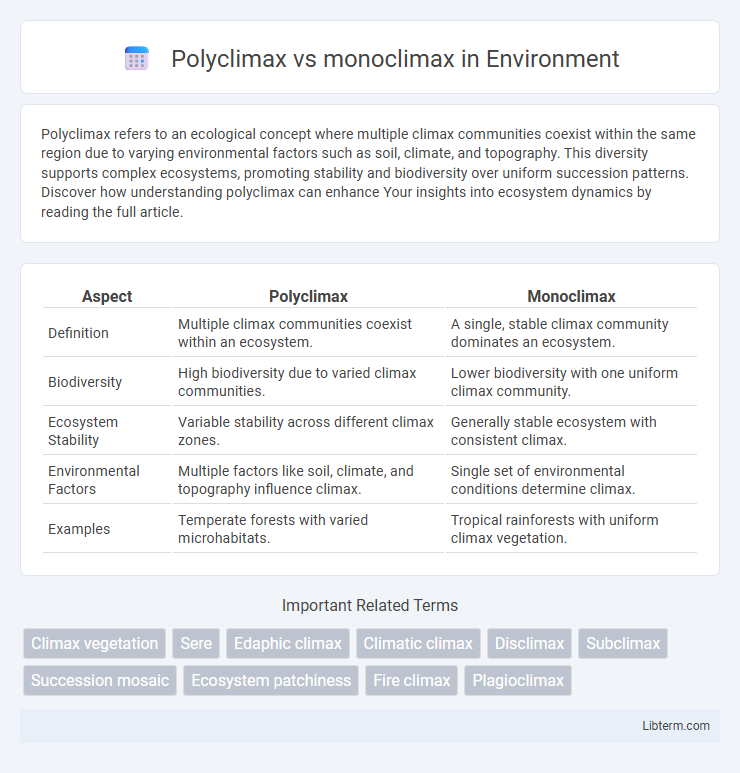Polyclimax refers to an ecological concept where multiple climax communities coexist within the same region due to varying environmental factors such as soil, climate, and topography. This diversity supports complex ecosystems, promoting stability and biodiversity over uniform succession patterns. Discover how understanding polyclimax can enhance Your insights into ecosystem dynamics by reading the full article.
Table of Comparison
| Aspect | Polyclimax | Monoclimax |
|---|---|---|
| Definition | Multiple climax communities coexist within an ecosystem. | A single, stable climax community dominates an ecosystem. |
| Biodiversity | High biodiversity due to varied climax communities. | Lower biodiversity with one uniform climax community. |
| Ecosystem Stability | Variable stability across different climax zones. | Generally stable ecosystem with consistent climax. |
| Environmental Factors | Multiple factors like soil, climate, and topography influence climax. | Single set of environmental conditions determine climax. |
| Examples | Temperate forests with varied microhabitats. | Tropical rainforests with uniform climax vegetation. |
Introduction to Climax Concepts in Ecology
Climax concepts in ecology describe the final stage of ecological succession where ecosystems reach a stable and mature state. Polyclimax theory suggests multiple climax communities can coexist, influenced by varying environmental factors such as soil, topography, and climate, resulting in diverse stable states within a region. Monoclimax theory posits a single, uniform climax community dominates an area under stable climatic conditions, emphasizing a single steady-state endpoint of succession.
Understanding Polyclimax Theory
Polyclimax theory challenges the traditional monoclimax concept by proposing multiple stable climax communities within a given region, influenced by variations in soil, climate, and topography. This theory emphasizes the role of diverse environmental factors and disturbance regimes in shaping distinct climax ecosystems rather than a single, dominant climax vegetation type. Understanding polyclimax dynamics enhances ecosystem management by recognizing the complexity and heterogeneity of ecological succession patterns.
Overview of Monoclimax Theory
Monoclimax theory asserts that ecological succession in a given region culminates in a single, stable climax community determined primarily by the area's climate. This concept emphasizes a uniform endpoint where species composition remains relatively constant unless disrupted by external forces. The theory contrasts with polyclimax models, which acknowledge multiple potential climax states influenced by factors such as soil, topography, and disturbance regimes.
Key Differences Between Polyclimax and Monoclimax
Polyclimax ecosystems exhibit multiple stable climax communities coexisting in the same geographical area due to variations in environmental factors and disturbances, whereas monoclimax ecosystems tend to develop a single, uniform climax community dictated by the prevailing climate. Polyclimax regions demonstrate higher biodiversity and resilience as diverse climax types adapt to microhabitats, while monoclimax areas have less species variety but a more predictable ecological climax stage. The key difference lies in the complexity of ecological succession patterns, with polyclimax allowing for heterogeneous climax development and monoclimax resulting in a homogeneous climax ecosystem.
Influencing Factors in Climax Community Formation
Polyclimax and monoclimax concepts differ primarily in how environmental factors influence climax community formation; polyclimax theory emphasizes multiple stable climax communities determined by local variables such as soil type, climate, and topography, while monoclimax theory supports a single, uniform climax community shaped predominantly by regional climate. Soil fertility and moisture regimes significantly affect species composition in polyclimax areas, promoting diverse climax stages across different microhabitats. Topographical variations, such as slope and aspect, further contribute to varied climax communities in polyclimax regions, contrasting with the monoclimax model's assumption of a uniform endpoint across a landscape.
Historical Development of Climax Theories
The historical development of climax theories began with Frederic Clements' monoclimax concept, which proposed a single, stable climax community for a given region, emphasizing a deterministic succession process. Later, Henry Gleason challenged this view by introducing the polyclimax theory, recognizing multiple possible climax communities influenced by varying environmental factors such as soil, climate, and disturbance regimes. This shift from monoclimax to polyclimax models marked a critical evolution in ecological thought, highlighting ecosystem diversity and the complexity of succession pathways.
Ecological Implications of Polyclimax
Polyclimax ecosystems feature multiple stable climax communities coexisting within the same region due to variations in soil, climate, and topography, enhancing biodiversity and ecological resilience. This diversity of climax stages supports complex food webs and habitat heterogeneity, promoting species richness and ecosystem stability. In contrast to monoclimax systems, polyclimax regions exhibit greater adaptability to environmental changes and disturbances.
Monoclimax Theory: Strengths and Critiques
Monoclimax theory posits that a single climax community dominates ecological succession in a given region, resulting in a stable and predictable endpoint influenced primarily by climate. Strengths of this theory include its simplicity and ability to explain uniform climax vegetation patterns across similar climatic zones. Critiques highlight its oversimplification, neglecting factors like soils, disturbance regimes, and multiple successional pathways that lead to diverse climax communities, which polymclimax theory better addresses.
Case Studies Comparing Climax Models
Case studies comparing polyclimax and monoclimax models often highlight the complexity of ecological succession influenced by climate, soil, and topography. Research in the Amazon rainforest reveals multiple stable climax communities (polyclimax) shaped by varied microclimates, contrasting with studies in temperate regions like New England, where uniform climatic conditions support a monoclimax model with a single dominant climax vegetation, typically deciduous forest. These comparative analyses underscore the importance of regional environmental heterogeneity in determining whether polyclimax or monoclimax conditions prevail.
Conclusion: The Future of Climax Theories in Ecology
Polyclimax theory recognizes multiple stable climax communities shaped by varying environmental factors, while monoclimax theory supports a single, dominant climax for a given region. Contemporary ecological research increasingly supports the polyclimax perspective due to its alignment with observed biodiversity and landscape heterogeneity. Future climax theories will likely integrate dynamic environmental variables and human impacts, advancing ecosystem management and conservation strategies.
Polyclimax Infographic

 libterm.com
libterm.com